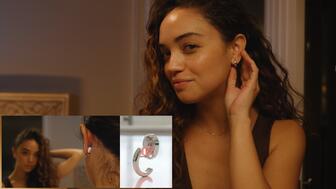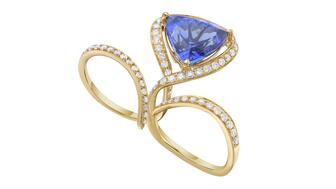Carlos Jose Hernandez and Joshua Zuazo were sentenced to life without the possibility of parole in the 2024 murder of Hussein “Sam” Murray.
Dissecting De Beers' 'distribution update'
After a sleepy couple of weeks, news wise, De Beers woke up the diamond world on Monday when it announced a series of changes, a "distribution update" if you will, to the way it sells its rough diamonds. See story...
After a sleepy couple of weeks, news wise, De Beers woke up the diamond world on Monday when it announced a series of changes, a "distribution update" if you will, to the way it sells its rough diamonds. See story here.
Probably the biggest change: De Beers announced that Diamond Trading Co. (DTC) sightholders--those vaunted companies that receive rough directly from De Beers at its 10 sights (sales of rough diamonds) held throughout the year--will be able to buy rough at Diamdel auctions beginning in October (more on this below).In addition, De Beers also announced that it will give non-sightholder companies the chance to apply for the sightholder status in the midst of the next contract period and that it is taking steps to make the sightholder application process less cumbersome. I'm sure the latter, especially, is a welcome change, as I have heard numerous complaints about the heavy volume of paperwork involved in applying.
After dissecting the alphabet soup-like release (SoC, ITO, DTC, CPQ, whew...), I sent a few questions to De Beers' spokeswoman Lynette Gould in London, who kindly took time to answer via e-mail.
Q. What percentage of De Beers' production goes to Diamdel? How much of Diamdel's allocation is currently sold at auction?
A. De Beers typically sells up to 10 percent of its annual production to Diamdel, which is basically De Beers' rough diamond sales and distribution arm for non-sightholders, companies that are also referred to as the "secondary market." Launched in the beginning of 2008, Diamdel is based in the diamond-trading center of Antwerp, Belgium, and conducts all of its auctions online.
The amount Diamdel sells at auction as a percentage of its total sales varies, but so far has ranged between 40 and 70 percent.
Q. What percentage will Diamdel's auction sales graduate to as the company "continues to transfer more of its allocation into the auction format?"
A. (Note from blog author: Very interesting response here.) If this pilot program is successful, Diamdel will move to an auction-only model.
Q. How many existing Diamdel customers are there currently, and how are they chosen?
A. Diamdel has more than 500 customers registered. They must successfully complete a registration process to be eligible for participation at auctions.
Q. There have been reports that Diamdel has, in the past, not been able to sell all of its goods, and that it has even canceled auctions due to lack
A. Diamdel has never cancelled an auction due to a lack of interest or inability to sell. On occasion, lots fall short of reserves, although, to date, this has happened on a very small percentage of lots and was most notable during the downturn.
Q. What was the impetus behind letting sightholders buy at auction?
A. Diamdel has proven expertise at auctioning and we believe the time is right for this expertise to be tested on a wider group of applicants with an expanded volume and range of goods hence the pilot.
Q. How does De Beers respond to concern that allowing sightholders into Diamdel auctions will make securing rough even more difficult for non-sightholders, particularly for in-demand goods?
A. Diamdel auctions have provided more customers with more opportunities to buy the rough they require to sustain their operations than the previous placed sales model created. The pilot will build upon this and provide greater volumes of a broader range of rough for purchase at auctions on a more consistent basis. Subject to the outcome of the pilot and availability, this proposed model will offer non-sightholders who consistently demonstrate strong demand for categories of rough at auction the potential to ultimately qualify for a sight.
The auctions themselves won't favor one type of business model over another.
(Note from blog author: Arguably, though, I have to say that auctions, by their very nature, favor bigger companies and/or people with more money, i.e., the sightholders.)
Q. What has been sightholder feedback on De Beers' plans to allow non-sightholders/Diamdel customers to compete for sights in the middle of the next contract period?
A. The majority of feedback we have received has been very positive. Sightholders see opportunities in these enhancements.
Q. Can you elaborate a bit on the Contract Proposal Questionnaire (CPQ) portion of the changes? How did it work before? And what is the purpose of this change?
A. The DTC will be streamlining the Supplier of Choice application process for the 2011-2015 contract period to make it quicker, simpler and more efficient. This will include submitting just one CPQ per applicant to cover multiple categories of goods. There will also be fewer questions requiring written answers in the new CPQ.
The Latest

Yood will serve alongside Eduard Stefanescu, the sustainability manager for C.Hafner, a precious metals refiner in Germany.

The New Orleans jeweler is also hosting pop-up jewelry boutiques in New York City and Dallas.

How Jewelers of America’s 20 Under 40 are leading to ensure a brighter future for the jewelry industry.

Set in a Tiffany & Co. necklace, it sold for $4.2 million, the highest price and price per carat paid for a Paraíba tourmaline at auction.


The jeweler’s “Deep Freeze” display showcases its iconic jewelry designs frozen in a vintage icebox.

Take luxury gifting to new heights this holiday season with the jeweler’s showstopping 12-carat sphene ring.

Roseco’s 704-page catalog showcases new lab-grown diamonds, findings, tools & more—available in print or interactive digital editions.

This year's theme is “Unveiling the Depths of the Ocean.”

In its annual report, Pinterest noted an increase in searches for brooches, heirloom jewelry, and ‘80s luxury.

Starting Jan. 1, customers can request the service for opal, peridot, and demantoid garnet.

The 111-year-old retailer celebrated the opening of its new location in Salem, New Hampshire, which is its third store in the state.

The new catalog features its most popular chains as well as new styles.

The filmmaker’s personal F.P. Journe “FFC” prototype was the star of Phillips’ recent record-setting watch auction in New York.

The new location in the Design District pays homage to Miami’s Art Deco heritage and its connection to the ocean.

Inflations, tariffs, and politics—including the government shutdown—were among consumers’ top concerns last month.

“Longtime favorite” presenters, as well as first-time speakers, will lead talks and workshops at the annual event in Tucson next year.

Silas Smith of Meridian Metalworks won the challenge with his pendant that blends Australian and American landscapes.

The sale of the 31.68-carat, sunset-hued stone was part of Sotheby’s first series of events and auctions in Abu Dhabi.

Most customers who walk into your store this month have made up their minds. Your job is to validate their choice, Emmanuel Raheb writes.

The collection features characters and motifs from Ukrainian folklore, including an enchanted mirror and a magic egg.

MatrixGold 3.11, the newest version of the jewelry design program, offers more flexibility, precision, and creative control.

The pavilion will be part of the 2026 JA New York Spring show, scheduled for March 15 to 17.

Kadet, a 1994 National Jeweler Retailer Hall of Fame inductee, helped grow the family-owned retailer in the Chicago area and beyond.

Billed as the world’s smallest wearable, Lumia Health’s new smart earrings have a health tracker subtly embedded in the back.

Don’t let those with December birthdays feel blue. Help them celebrate their month with blue zircon, turquoise, and tanzanite.

The new pink sapphire version of the piece dances with its wearer in the brand’s “Icons After Dark” holiday campaign.


























